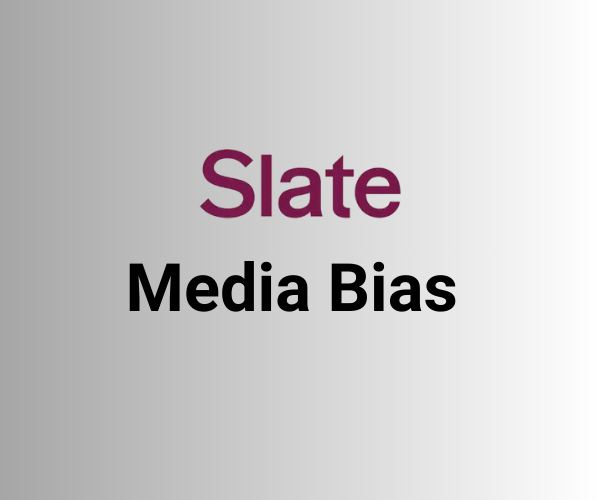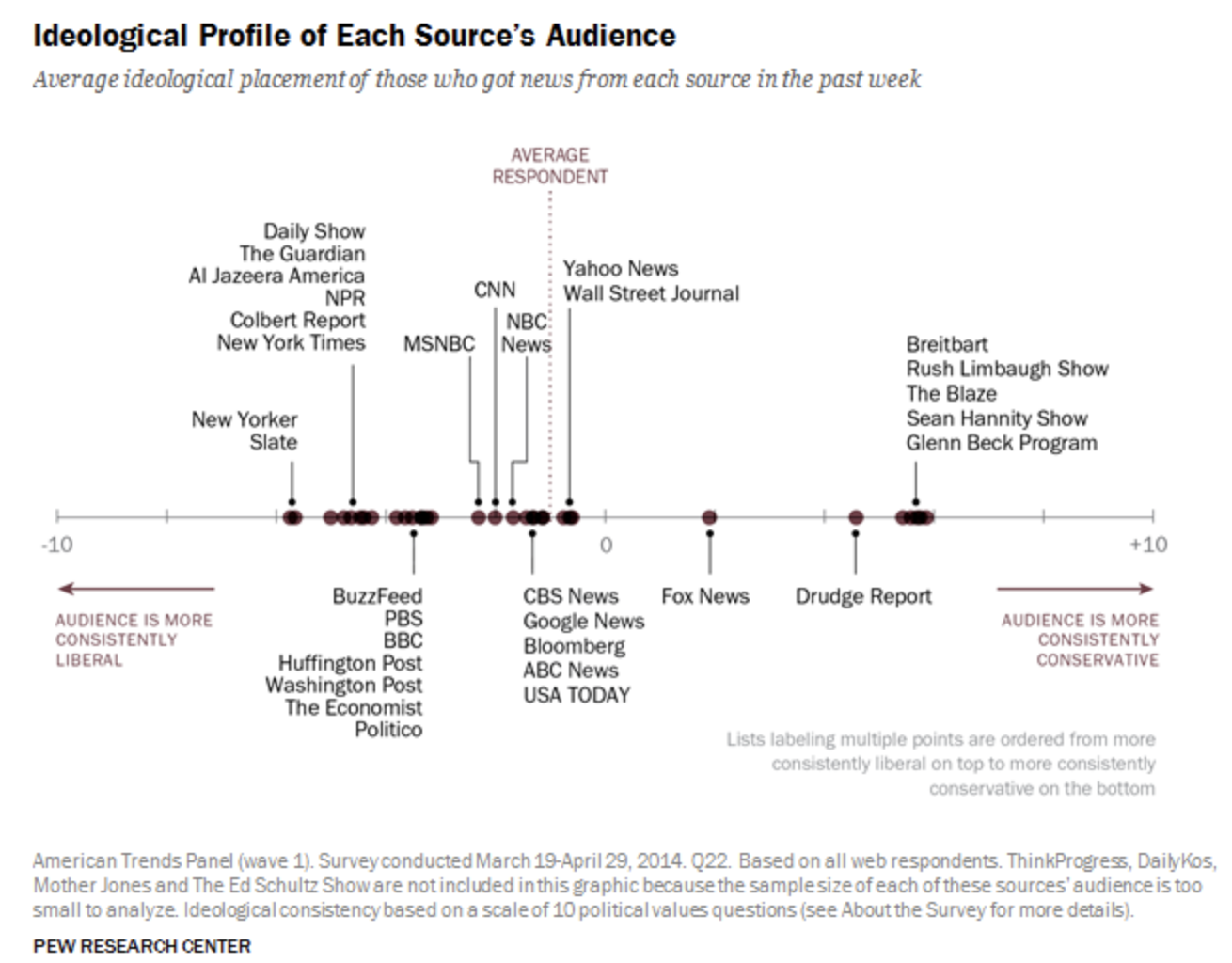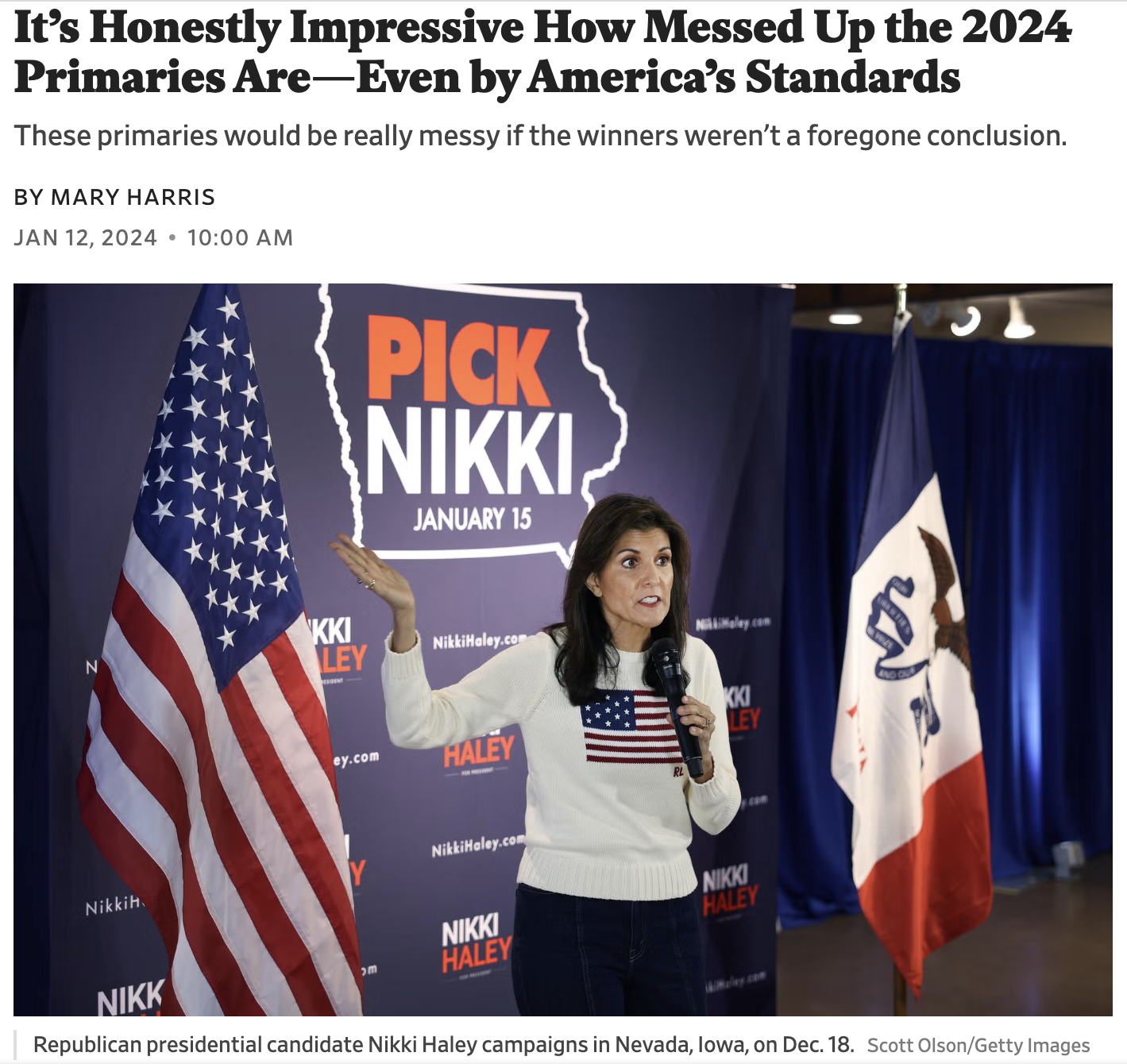
Founded in 1996, Slate is an online magazine that focuses on politics, current affairs, business, technology, and other news in the United States. With an average of 19 million monthly visits it has been ranked 21st in the law and government category compared to other sources. This viewership makes it pertinent to address whether Slate incorporates political bias into its reporting.
Slate is known to have a strong left-leaning bias. In 2014, a Pew Research study showed that 76% of readers fall on the left side of the political spectrum, making it understandable that Slate would cater its news toward the ideologies of its majority audience. Among the sources it analyzed, Pew placed Slate among those with the most consistently liberal viewers (as displayed below).

Source: Pew Research
In this article, Slate’s coverage will be analyzed to determine where and how political bias is present. The objective is to investigate said bias and inform the public on how to recognize it. We will address how included bias influences the reporting, editing, and inclusion of news.
How Does Biasly Rate News Sources?
Biasly’s algorithms produce bias ratings to help provide multiple perspectives on given articles. Biasly has analyzed 200,000+ news articles from more than 3,200 news sources through our A.I. technology and team of political analysts to find the most factual, unbiased news stories.
Biasly determines the degree of political bias in news sources by using Biasly’s Bias Meter Rating, in which Biasly’s team analyzes media sources’ reliability and bias and produces three scores, a Reliability Score that measures the accuracy of media sources; an A.I. Bias Score, evaluated by A.I.; and an Analyst Bias Score evaluated by political analysts. These scores are rated based on seven rating metrics including Tone, Tendency, Diction, Author Check, Selection/Omission, Expediency Bias, and Accuracy. These metrics help our analysts to determine the political attitude of the article.
Our A.I. machine-learning system employs natural language processing and entity-specific sentiment analysis to examine individual articles and determine their bias levels. By analyzing the key terms in an article such as policies, bias phrases, political terminologies, politicians, and their nicknames, the algorithms can rate the attitude of the text. Bias scores range from -100% and 100%, with higher negative scores being more liberal and higher positive scores being more conservative, and 0% being neutral.
Is Slate Politically Biased?
Biasly’s rating for Slate Magazine comes from two scores. The first originates from computer algorithms based on A.I. technology, and the second stems from trained analysts. Biasly categorizes both the Computer Bias Score and Analyst Bias score for Slate as being “Very Liberal”. This means that the subjects covered in their articles are typically written from a strong liberal perspective. An average of fifteen articles are examined by the Biasly analyst team to provide an accurate rating. The score will become increasingly precise as more articles are reviewed. The assigned scores are also similar to those of several third-party bias research agencies, further supporting Biasly’s ratings.
Slate has reportedly been increasing their left-leaning bias in recent years, causing some displeasure among readers. There has been criticism from right-leaning individuals that a more conservative perspective is absent, making their reports unbalanced. This is an issue that has been acknowledged by Slate staff members on their site as well.
One individual writes:
“It feels like more of Slate’s recent content assumes that the reader shares the author’s expressed liberal viewpoint… Adding more articles from writers with equally visible conservative viewpoints could be interesting. I would hope that they would write about issues and events that could just as easily be covered by a writer with a liberal viewpoint and that the reader would come away with a similar understanding of the facts (albeit with likely a different interpretation).”
Furthermore, a staff member admits:
“It seems to me that Slate has a bias towards D.C. and NYC. Many of its writers demonstrate a cluelessness about the lives of people who do not live in those [areas]. From reading the Slate comments it appears that your readership is more regionally diverse than your staff. I suppose that this would also explain the lack of political diversity amongst your writers as well.”
While geographical bias must be distinguished from partisan bias, they remain interconnected as location tends to affect ideological views.
Even with this admission, several staff members argue against creating a “false balance,” which has led to articles that claim certain beliefs as fact. This further supports an absence of diverse political opinions. That being said, readers should be cautious of projecting their own political bias into the news they are reading. In the remainder of this article, we will discuss ways to identify our bias so that fact can be discerned from opinion and we can become more reliable consumers of information.
Before we begin, we need to discuss bias. Bias is a natural function of humans, and we can express it both consciously and unconsciously. Bias is one of the most fundamental forms of pattern recognition in humans. This isn’t to lower the bar and say that “all things are biased,” but to explain the process in which we may come to trust certain news organizations that display patterns of coverage.
On the media’s part, there is an incentive to retain audiences, encourage them to purchase subscriptions, and rate products positively. Bias is a two-way street, people want to see news stories about things they care about, and the media needs viewers to continue their operations. This creates a positive feedback loop that influences what stories are covered and from what perspective. This also explains the actions of more liberal news organizations.
Analysis of Bias in Slate Online Articles
According to its website, Slate’s audience tends to be educated and affluent. 61% of readers have a college degree or higher, with the mean income reaching slightly over $90,000. 69% of the audience falls between the ages of 25-54. It is important to note that these statistics come from Slate with little information posted elsewhere on its audience demographics. These statistics were also found in and have remained unedited since 2002. If they are still accurate, would the education and age of the audience influence the amount of bias included in Slate’s reporting? To answer this question, we must examine several articles in more depth.
The most common categories that must be observed when determining bias include tone, tendency, author, diction, and expediency bias. To begin, tone refers to the author’s opinion and their tendency to favor one political side over another. This includes the overall attitude of the piece regarding whether it is presented positively or negatively. The tendency is the frequency in which tone occurs throughout the article and examines the consistency in which bias is applied. The author category more closely inspects the author of a particular article and investigates their agenda, affiliation, and potential bias. Diction refers to the word choices used throughout a report, and analysts look for any harsh words meant to inspire an emotional reaction in the reader. Lastly, expediency bias is the first impression resulting from a headline, summary, or image. Each of these must be examined to see if they favor a particular political agenda or evoke a specific emotion.
The first article we will examine highlights the diction used to inspire an extreme emotional reaction in the reader. The title alone, “The Chaos in Trump’s New York Civil Trial Portends Bad News for Jack Smith,” with its use of “chaos” also exhibits expediency bias, as the author attempts to sway readers toward having a negative attitude of the trial before they continue reading. The article begins:
“As with all things in Trump world, just when you think there is no lower behavioral place to go, new depth-defying plunges occur.”
This quote is referring to the civil fraud case brought against Donald Trump, his sons, and his organization by the New York attorney general. The “lower behavior place” being reached is supposedly Trump’s defense summations, which were labeled by the author as being “unprofessional,” “self-defeating,” and “baseless.” Coinciding with word choices such as “lower,” “shameful,” and “incompetent,” the diction used clearly favors a bias against the former president, his attorney, and many of his associates. The author, Robert Katzberg, describes the trial proceedings in an exceedingly negative light to support his opinions, and his liberal tone is persistent throughout the majority of the article.
“What is new is the decision to have Trump address the court directly and hurl the multifaceted lies straight to the judge’s face.”
This sets a very clear tone that negatively represents Donald Trump. “Multifaceted lies” is also an instance of strong diction meant to sway the reader, making it more difficult for readers to distinguish fact from opinion, and creating preconceived notions for Donald Trump without appropriate background and context. One more example of the strong tone, and the tendency to which it supports liberal ideas, reads:
“But, as has been abundantly clear for some time now, decisions made by Team Trump are almost always based primarily on their potential political impact, with little to no regard for the legal result—after all, as he believes, if he is president again, he can undo whatever needs to be undone.”
The opposing stance is neglected in this article and the information appears largely subjective. Katzberg consistently criticizes Trump and his campaign, even when the claims are unnecessary and lack pertinent details.
Next, let us look at expediency bias on Slate’s website, as this form of persuasion is reflected in many reports. For example, this piece on the 2023 presidential elections.

Source: Slate.com
The title encourages the reader to have a discouraging view of the 2024 primaries before the facts are appropriately expressed. The image used shows Republican candidate, Nikki Haley, in a pose also seemingly supporting the overall theme of confusion.The image hints that the right side of the political spectrum is more responsible for uncertainty surrounding upcoming elections. Biasly’s News Check Chrome Extension rates the article as “Center,” and while it does include important information about primaries in different states, the tone and diction used against Republican candidates incorporates left-leaning bias.
Another article to look at is “Vivek Ramaswamy’s Spring to Cram As Many Virulent, Far-Right Conspiracy Theories As He Could Into the Last Debate.” Biasly’s Chrome Extension categorizes this as being “Extremely Liberal”. The diction and tone work to criticize the conservative candidate, as well as other, right-leaning viewpoints.
“It was the night of the fourth and final GOP presidential debate and Vivek Ramaswamy remained true to form: really annoying and desperate for attention. When the 38-year-old Republican wasn’t picking fights on stage with the other primary candidates (usually former U.N. Ambassador Nikki Haley or former New Jersey Gov. Chris Christie), he was proudly pushing outlandish and dangerous far-right conspiracy theories.”
The article implies that it will discuss Ramaswamy’s role in the last presidential debate; however, the language utilized presents him unfavorably. Diction such as “really annoying and desperate for attention,” and “pushing outlandish and dangerous far-right conspiracy theories,” highlights a bias for a left-leaning ideology. The tone favoring this ideology is consistent throughout the piece, as the author also uses her platform to criticize Donald Trump. The final paragraph states:
“Despite being three years out from his second presidential election loss, Trump continues to promote baseless claims that the 2020 election was fraudulent and stolen from him, and will basically push any conspiracy theory that works for him and his base. Ramaswamy’s tactics weren’t novel. But the cynical way he rattled them off made for a new kind of low.”
The author, Shirin Ali, was attempting to compare the tactics of Ramaswamy to Trump’s own, but does so in a subjective manner. While she seeks to address Ramaswamy’s talking points, she inserts her own perspective into her writing, as seen especially in the aforementioned quotes.
Shirin Ali reveals some of her left-leaning biases in her tweets and re-posts, many of which deal with the upcoming election, former president Trump’s trial, and abortion laws.
Despite Roe being struck down, there are still many states with protective abortion policies!
my latest:https://t.co/HqMSzLdo6T
— Shirin Ali (@shirinali_) June 24, 2022
Is he gonna get handcuffed? Extradited? Go to prison? Your questions, answered. https://t.co/axxlD2zjEj
— Slate (@Slate) March 30, 2023
While the three pieces discussed favor the left side of the spectrum, bias varies between different articles and authors. It is necessary to be aware of the signs of bias so that it can be recognized in each source. Readers should look for tone, tendency, diction, author, and expediency bias in each article they read, even when browsing the same site.
To see an example of an article with little to no bias, we must observe “The Biden-Xi Meeting Went Well. Here’s What That Means,” by Fred Kaplin The author uses this piece to explain the meeting that occurred between U.S. President Joe Biden and China’s President Xi Jinping in November of 2023 in a fairly unbiased and straightforward manner. The reader receives a thorough explanation of the encounter while still being allowed to form their own conclusions. Biasly’s A.I. bias meter also labels this article as “Center.”
Analysis of Slate Opinion Articles
When discussing this, the difference between opinion and reporting should be established. Reporting is meant to be an unbiased account of factual information from primary sources, and the reader should form their own opinion based on objective materials. In opinion articles, the author(s) highlight their personal views on an issue/event. While Slate has neutral pieces, as seen above, it also contains works based on opinion.
For example the article titled “The House is Now Seeing What Kind of Speaker it Elected. Oops.” The expediency bias is notable in the title, as it immediately presupposes that a mistake was made regarding the current Speaker of the House, Mike Johnson. The article continues to cast negative viewpoints on several other relevant U.S. politicians while sharing little actual news. The language is based almost entirely on emotion, encouraging the reader to react strongly to the author’s observations.
That being said, objective articles can still be found on Slate, although they are not common. The objective articles that are present more frequently address world politics than domestic issues. For example, “What Gaza’s Future Might Look Like After the War,” by Amy Mackinnon. Biasly’s A.I. rating is “Center,” as the article primarily consists of facts and objective reporting. There is no clear emphasis on or favor for either side of the Israel-Palestine conflict, and the author addresses issues that will affect both nations in the future. There is no emotional language or overarching tone, allowing the reader to form their own opinion on the content.
“While an Israeli ground invasion is likely to deal a devastating blow to Hamas’ commanders, its foot soldiers, and its arms caches, many analysts noted that the only long-term solution to address Israel’s need for security and Palestinians’ hopes for self-determination is to work toward a political solution to the conflict.”
This quote provides a very neutral overview of the situation without settinging a tone that emphasizes a particular political agenda. The remainder of the article suggests several possible political solutions to the conflict, listing the pros and cons of each without stating a clear preference. Objective reporting like this allows the reader to form their own educated opinion based on facts.
Despite this, the majority of articles by Slate Magazine promote a significant amount of subjectivity. That being said, the aforementioned pieces are only a small sample of the coverage that can be found on their website.
Who Owns Slate?
Slate is overseen by the Slate Group, an online publishing unit managed by Chief Executive Officer Dan Check. This unit is owned by the Graham Holdings Company, with the majority owner being Donald E. Graham. While these two members do not openly identify with a political party, the Editor-in-Chief, Hillary Frey, has expressed left-leaning opinions in her social media. In conjunction, one Slate Contributor acknowledged in a 2019 article that Slate’s previous centrist view has shifted in recent years to a more left-wing slant.
How to Evaluate and Uncover Bias
It can often be difficult to tell if the news you watch is biased. If you have settled on a news channel, it’s usually because you trust the information you are gaining. Unfortunately, many trust the information they are hearing because it confirms what they already believe. This is referred to as “confirmation bias.” It is important to challenge your beliefs and get third-party verification that what you are hearing is the full story. This is why we recommend using Biasly to compare different news stories side-by-side using our bias ratings to figure out what both sides think of a political issue.
To reiterate, Biasly rates Slate Magazine as being “Very Liberal”. It is still necessary to remember that the same type and level of bias will not be present in every report. Several of Slate’s reports are centrist, although there is a noticeable lack of conservative views. Addressing this, Slate has said that “ integrity—as measured in fidelity to facts and rigorous critical thinking—was far more important than any semblance of ideological ‘balance.'” While Slate declares that it appreciates facts, it is worth mentioning that many of the facts they emphasize are only included if they support a Democratic agenda. Again, this differs with each article, which increases the important role Biasly’s News Check has in determining bias.






















